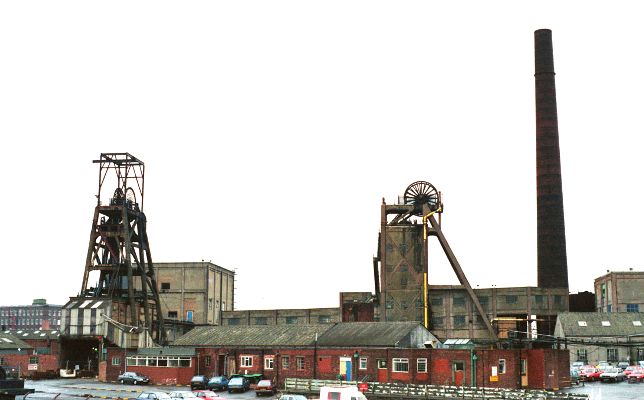
Parsonage Colliery 1989
Copyright © Frazerweb and used with permission
The two shafts were sunk to the Arley seam at 2997 feet. The shafts were 21 feet in diameter and lined with brick. Sinking began in 1913 but was halted for two years in early 1914 because of the outbreak of war.
In 1923 Nos. 1 & 2 pits employed 85 underground and 75 surface workers. By 1933 this had risen to 1,261 underground and 287 on the surface.
From 1,044 tons of coal in 1921, output increased to 252,188 tons in 1925 and by 1930 output was 325,000 tons.
The colliery became part of the National Coal Board in 1947 and subsequently it was linked underground to Golborne and Bickershaw collieries.
The colliery closed in 1992.
Further information:
The following is Copyright © NMRS Records: G. Hayes Collection
| COLLIERY | PARSONAGE | ||||||
|---|---|---|---|---|---|---|---|
| LOCATION | West Leigh. (west of West Leigh station on the LNWR Bolton – Kenyon Jc. line) | ||||||
| OWNERS |
|
||||||
Shafts
No.1 (upcast) and No.2 (downcast) sunk to Arley Mine at 993 yards, 1008 yards into sump. Diameter 21 feet, brick lined. Sinking commenced January 1914, stopped for two years during World War I, Arley Mine reached in 1920.
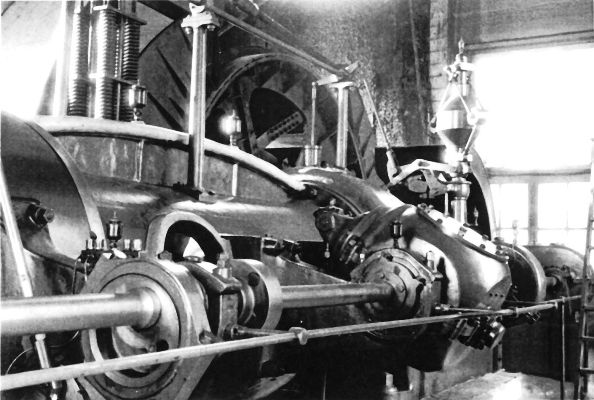
Winding engine, No.1 Pit
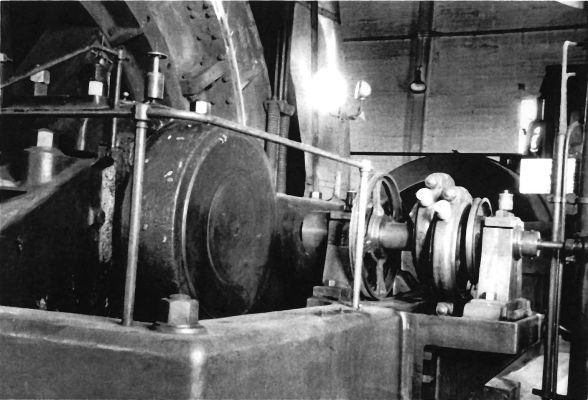
Winding engine, No.2 Pit
Winding
No.1 Pit, Twin cylinder horizontal engine 40 inches x 72 inches, by Messrs W & J Galloway, Manchester, 1920. Drop valves, layshaft drive and differential gearbox reversing. Melling’s reversing engine, Melling’s pneumatic controller and (latterly) Black’s spring brakes. Original winding drum bi-cylindro-conical 16 feet – 22 feet diameter, later replaced by 17 feet diameter parallel drum with balance ropes under cages. Winding ropes 2 inches diameter, locked coil. Rated at 54 winds per hour from 700 yards. Double deck cages, four – 10 cwt tubs per deck. Four wire rope conductors to each cage. Simultaneous decking with drop cages.
No.2 Pit, twin cylinder horizontal engine 40 inches x 84 inches by Markham & Co., Chesterfield, 1920. Drop valves, wrist plate and Gooch link motion drive, Melling’s reversing engine, Melling’s pneumatic controller, Black’s spring brakes (latterly). Winding drum BCC 16 feet – 28 feet, winding ropes 21/32 inches diameter locked coil. Engine rated at 45 winds per hour from 998 yards. Double-deck cages, four – 10 cwt tubs per deck. Four rope conductors per cage plus four rubbing ropes between cages. Simultaneous decking with drop cages.
Headgears 88 feet high to centre of pulleys, Pulleys 18 feet diameter. Headgears and engine houses constructed in re-enforced concrete.
Both winding engines replaced by electric winders 1977/78.
Sinking Arrangements No.2 Pit
Sinking engine twin cylinder horizontal 24 inches x 54 inches, 12 feet x 5 feet drum plus brake path each side 6½ inches wide. (A “pair” of 24 inches x 54 inches winding engines were supplied to WC&ICo. in 1899, No.746/7 by Wood & Gee. Possible these were for Manton sinking and re-used at Parsonage)
Scaffold capstan engine, twin horizontal 12 inches x 20 inches, drum on third motion shaft, 5 feet diameter x 2 feet 10 inches wide each side of a centre division 2¼ inches wide. Gear ratio 20:1.
Wooden headgear 59 feet 3 inches to pulley centres. Winding pulley 10 feet diameter, two capstan pulleys 5 feet diameter.
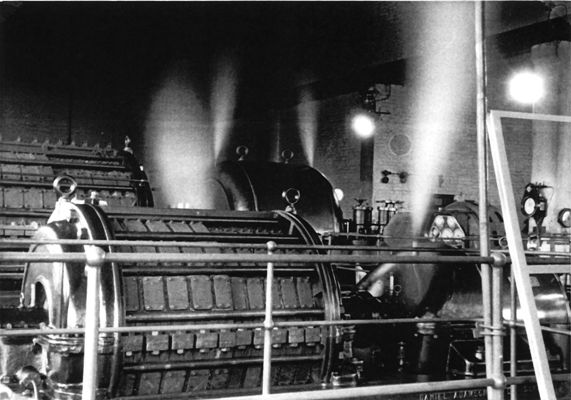
Daniel Adamson mixed pressure turbo-compressors
Power
Two Daniel Adamson mixed pressure turbo-compressors. Larger set 12,000cfm. at 100psi.
Stand-by compressor Walker Bros. 4000cfm. reciprocating vertical.
1500kW Daniel Adamson/English Electric mixed pressure turbo-alternator, three-phase, 2200 volts.
Compressed air and electrical power also supplied to Priestner’s Colliery.
Underground Haulage
Main haulages, electric, endless over-rope system. Subsidiary haulages compressed air operated. Conveyor belts first introduced during 1930s.
Pumping
Electrically driven multi-stage centrifugal pumps.
Ventilation
Walker “Indestructible” fan, 28 feet x 9 feet, 750,000cfm. at 6 inches wg.
Twin-tandem compound engine 21 inches + 36 inches x 42 inches. Twenty – 17/8 inches diameter cotton ropes from flywheel to fan pulley. Fan latterly electrically driven.
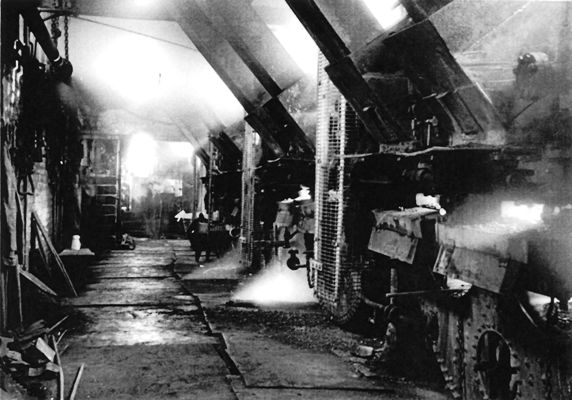
Five of the thirteen Lacashire boilers
Boilers
Thirteen Lancashire boilers fitted with super-heaters and economisers. 150psi. Circular section brick chimney 225 feet high.
Output (1939) – 457,198 tons
Seams Worked
1948 – Crombouke, Bickershaw Seven Feet, Trencherbone, Arley.
1954 – Brassey (Ince Seven Feet), Rams (Ince Furnace), Peacock.
Workforce (1954) – U/G 1010, S/F 269.
CLOSURE
Linked to Bickershaw Colliery 1975.
Coal winding ceased May 1976, shafts retained for winding men and materials.
Complete closure 1992.
NOTE – No.2 Pit sinking engine probably sold to Newbury Collieries Ltd, Somerset, for Newbury Colliery, c1923. This colliery closed August 1927. (per Down/Warrington)
MAKER’S WINDING DIAGRAM, 40 inches x 84 inches
ENGINE. 16 feet – 28. BCC DRUM.
Markham & Co. Drg. No. L.513, dated 7-12-1921.
Steam pressure at throttle valve, 110psi.
Required winding time including changing tubs, 72 seconds.
Depth of shaft, 1000 yards.
Required tonnage 1500 tons in 7½ hours. (i.e. 3000 full tubs raised)
First four revolutions, cut-off 85%, initial steam pressure falls from 110psi. to 100psi.
Two revolutions at 50% cut-off
One revolution at 40% cut-off. (Initial pressure recovers to 105psi.)
Two revolutions at 38% cut-off
Five revolutions at 34% cut-off.
Two revolutions at 32% cut-off
Two revolutions at 30% cut-off.
STEAM SHUT OFF (after 18 revs.)
Revolutions for complete wind – 37.6
Steaming time 27 seconds
Running out and checking 24 seconds.
Counter steam 5 seconds.
Total winding time 56 seconds.
Max. velocity of cage 86 feet/second
Engine speed 58.4 rpm., piston speed 817 feet/minute.
NOTE – In 1929 both winding engines were only averaging 26 winds per hour. (780 tons per 7½ hour shift)
Return to previous page
